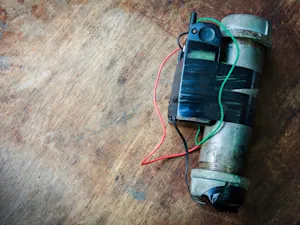
Green River Serial Killer Finally Caught After 49 Slayings
The Green River Killer haunted the streets of Seattle like a shadow, vanishing into the fog just as investigators closed in. For nearly two decades, Gary Ridgway roamed free, preying on young women and leaving behind a trail of heartache and mystery. With a list of victims that grew year after year, he stood as an enigma, always one step ahead. But what if the clues to his identity had been hiding in plain sight all along? What if a tiny piece of overlooked evidence could have saved dozens of lives? This is the story of how one of America's most notorious serial killers slipped through the cracks — and the fateful discoveries that finally ended his deadly spree.
Who was the man behind the Green River murders?
Gary Ridgway seemed like an ordinary man — a quiet truck painter who lived in suburban Seattle. But beneath that unassuming exterior lurked a predator. Between the early 1980s and 1990s, Ridgway stalked the vulnerable, targeting young women and teenagers, many of whom had been living on the edge, involved in prostitution, or running away from difficult lives.
He offered them rides, companionship, or a bit of safety, only to end their lives in the most horrific ways. Ridgway's ability to blend into everyday life helped him evade suspicion for years, allowing him to hunt in plain sight while authorities frantically searched for answers.
 Gary Ridgway 1982 mug shot, arrested for solicitation. Photo courtesy of King County Sheriff's Office. Public domain.
Gary Ridgway 1982 mug shot, arrested for solicitation. Photo courtesy of King County Sheriff's Office. Public domain.
How did Ridgway stay one step ahead?
Investigators found themselves locked in a race against time, desperate to uncover the identity of the killer as the body count climbed. The Green River Task Force, formed in 1982, threw everything they had at the case, pouring over countless pieces of evidence, following up on tips and interviewing potential suspects.
Ridgway even landed on their radar multiple times. In 1983, he became a prime suspect when Marie Malvar's boyfriend spotted her getting into Ridgway's pickup truck. But Ridgway kept his cool, talked his way out of police suspicion and even passed a polygraph test in 1984, slipping back into the shadows while the task force grasped at straws.
What critical evidence did investigators miss?
Hidden within the fabric of the victims' clothing lay the truth. Tiny, multicolored spheres of industrial spray paint — a unique brand used only at Ridgway's workplace, the Kenworth™ Truck Company — could have linked him to the crimes. This paint wasn't something you'd pick up at a hardware store — it was a specialty product, used only in the Seattle area during the early 1980s.
Incredibly, forensic experts didn't examine these microscopic clues back then. Instead, they focused on more conventional evidence like hairs and fibers, missing the one detail that could have cracked the case wide open.
Renowned trace evidence expert Skip Palenik later found these paint spheres still embedded in the fabric, over two decades after the murders began. He had the skills and technology to detect them back in the 1980s, but the Washington State Patrol Crime Laboratory never brought him in. By the time Palenik discovered this missed evidence in 2003, Ridgway had already claimed at least 49 victims. The question lingers: How many lives could have been spared if this tiny, overlooked clue had been found sooner?
How did investigators finally catch Ridgway?
By the early 2000s, DNA technology had advanced far beyond what detectives had in the 1980s. With hope fading and the trail growing cold, Detective Tom Jensen submitted DNA evidence from several victims for reanalysis. This time, scientists struck gold.
They matched Ridgway's DNA to three victims, and in November 2001, police arrested him. The faceless specter finally had a name, and the terror that gripped the Pacific Northwest began to fade.
The investigation didn't stop there. When Palenik joined the case in 2003, he used infrared microscopes to find the paint spheres on the victims' clothing, linking them to Ridgway's work at Kenworth. This irrefutable evidence left Ridgway with no room to hide. Under mounting pressure, he confessed to 48 murders, helping investigators find four more bodies and closing a dark chapter in Seattle's history.
 Booking Photo of Gary Ridgway, the Green River Killer, 2001. Photo courtesy of King County Sheriff's Office. Public domain.
Booking Photo of Gary Ridgway, the Green River Killer, 2001. Photo courtesy of King County Sheriff's Office. Public domain.
Could the murders have been stopped sooner?
This question haunts investigators and the families of Ridgway's victims. If forensic scientists had detected the paint evidence back in the 1980s, Ridgway might have faced justice years earlier. Retired King County sheriff's commander Frank Adamson, who led the Green River Task Force, expressed his dismay, saying, "It would have been nice if we could've saved a life or two — or all of them," according to NBC News. The paint evidence sat there, waiting to be discovered, but it fell through the cracks of an overburdened system.
Chesterene Cwiklik, who supervised the crime lab's trace evidence work at the time, admitted they focused on analyzing hairs and fibers, believing them to be the most promising leads. Only later did she realize they should have examined smaller particles. "It always bugged me that we didn't do that," she confessed, according to NBC News. The victims, their families and the investigators must now live with the haunting reality of what might have been.
What legacy did Ridgway leave behind?
Ridgway's capture provided some closure, but it couldn't erase the pain he inflicted. He destroyed countless lives, and his legacy serves as a grim reminder of how easily evil can hide in plain sight. The women he killed weren't just victims — they were daughters, sisters, mothers, and friends. Their stories, their hopes, and their dreams were cut short by a man who treated them as "just rags," as reported by NBC News. In November 2003, Ridgway accepted a plea deal, trading his confessions for a life sentence, sparing him the death penalty. He now spends his days in the Washington State Penitentiary, far from the lives he shattered.
Final lessons written in paint and blood.
The Green River Killer case stands as a stark lesson in the importance of vigilance, thoroughness, and relentless pursuit of justice. Gary Ridgway's reign of terror could have ended much sooner if investigators had caught that microscopic clue — the tiny paint spheres that linked him to his victims. Today, we remember the women who lost their lives and acknowledge the tireless efforts of those who finally brought their killer to justice. Their legacy demands that we never stop searching, never stop questioning, and never let a single clue slip through our grasp again.
References: How a crime lab missed evidence that could have stopped the Green River Killer | Timeline of the Green River killer case | Green River murders timeline | Gary Ridgway























